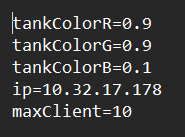Tank You, Next!
LAN Multiplayer Game
This project started as a small example project for my Software Engineering class at university. Together with my friend and fellow student Daniel we came up with the following Vision for the Project:
Two players each control one tank. This is done by the keys “W”, “A”, “S” and “D” and by using the mouse to aim and shoot. The tanks are on a (three-dimensional) platform together with some obstacles. Via a web Socket, the movements of the two players are synchronized. The player who hits the other player first (or often enough), wins the game. The game can then be started again.
As we recently dived into C++ for our Programming 3 lecture, we decided to use this programming language for the project. From the Computer Graphics lecture, Daniel already had experience with OpenGL, so he took care of the GUI based on OpenGL.
During the process of the software engineering lecture, we had to create many UML documents on our project to better visualize the structure. Let’s have a short look at them for getting a better understanding:

In this class diagram you can see the basic structure of the software. Our goal was to keep it as simple and lightweight as possible, while also keeping the interfaces between the components clean and small.

This sequence diagram shows the principle behind the “shooting” mechanism. Basically, the tank checks what keys are pressed and performs the according action. To ensure that everything is rendered correctly, the instantiated bullets have to be added to the ObjectPool.
The process of creating these and many other diagrams really helped to review the structure of our software in a visual way. Also it was way easier to explain our code to the other students as they already had an idea what the concept was.
While the visual OpenGL part was implemented by Daniel, I focused on the networking part. As the game should be playable via LAN, we needed some sort of client-server connection structure. On behalf of the boost asio library I came up with the following concept (left side):

Basically, the server as well as the client send and read the data packages in a “ping-pong-principle”. With this method we achieve a maximum throughput and it is extremely simple to implement. Also the networking is implemented completely encapsulated from the semantic of the game, i.e. the data transmitted is just a string and the interpretation is done seperately.
Even though the networking was designed to only support two players (one server & one client) in the first place, we have now modified the network structure in such a way that it supports an arbitrary amount of players / clients. The server acts as the central information storage, where each client sends its position to. The server responds then with the position information of all other tanks. The amount of clients which should be accepted by the server can be specified in a config file.
The just mentioned config file is also a new feature. Its main purpose is not only to specify the client amount but also to specify if the game should be launched as a client or as a server. In case of starting the game as a client, the server IP adress must be specified. Also, the user can now set a color for his tank using rgb values, which are also synced over the network. This helps to differentiate between all the different tanks / players during gameplay.

With these updates we have now achieved our initial goal of creating a simple tank game for LAN-parties. You can download the playable build for your own LAN-party from the github releases.
Nevertheless, there are still some bottlenecks which could cause problems, especially when playing with many players. The main problem here are the bullets, which are currently not sent just once over the network but are sent through the network “as long as they exist”. We have already been working on a solution where a player just sends the information that he has shot a bullet through the network once. This would drastically reduce the necessary network load and would therefore improve the whole game performance.
Still, I hope you enjoy the more or less final version of this project and I’ll keep you of course updated on any new improvements!